I. Ramos Arreguin (ed.) Automation and Robotics
Подождите немного. Документ загружается.

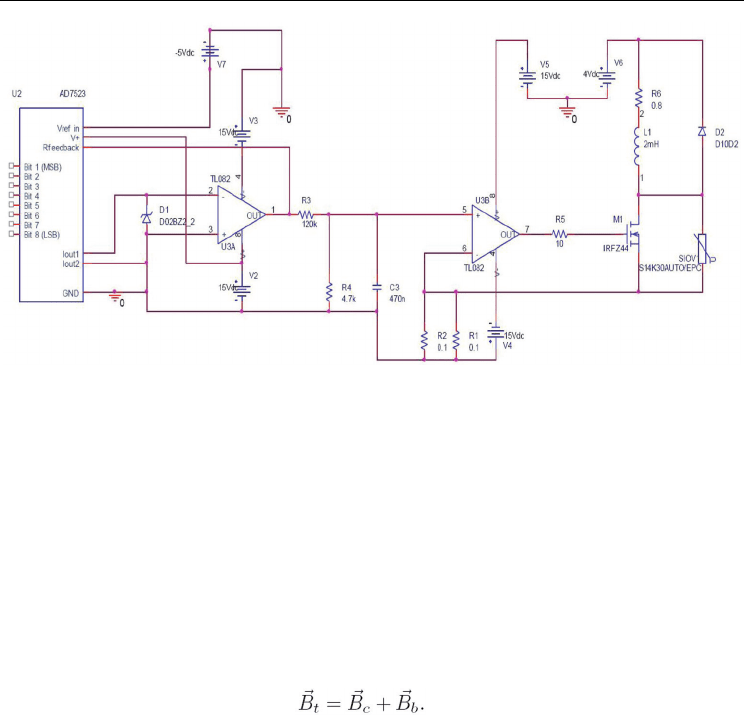
Model-Based Control of a Nonlinear One Dimensional Magnetic Levitation with
a Permanent-Magnet Object
363
Fig. 5. Diagram of the current generator
2.3 LabView environment
The control algorithm is implemented in the National Instruments (NI) LabView
environment for Windows XP. A Data Acquisition (DAQ) card typed NI PCI 6229 is used as
the interface between the physical hardware and the LabView software. More information
can be found in (Sønderskov & Østerö (2007)).
3. Modeling and identification
The entire magnetic field in the considered setup consists of two distinguished parts:
contribution from the permanent NIB magnet attached on the ball, and contribution from
the solenoid when electric current flows through it. This magnetic field can be expressed as
(1)
where
B
G
t
is the total magnetic field, B
G
c
is the magnetic field induced by the solenoid, and
B
G
b
is the field induced by the NIB magnet. In the following, the feature of B
G
b
is first
investigated
based on the setup. Then the total field B
G
t
is analyzed using a theoretical
approach. System parameters are identified through experiments.
3.1 NIB magnetic field
G
b
B
The NIB magnetic field is investigated through an experiment way. It is obvious that the
magnetic field B
G
b
will be influenced if the distance between the solenoid and the ball
becomes smaller even without any current running in the coils around the solenoid
(Woodson & Melche (1968)). Thereby we define the magnetic field generated by the NIB
magnet as a function of the distance between the bottom of the solenoid and the top of the
ball, denoted as
B
G
b
(x), where x is the mentioned distance. This magnetic field function can
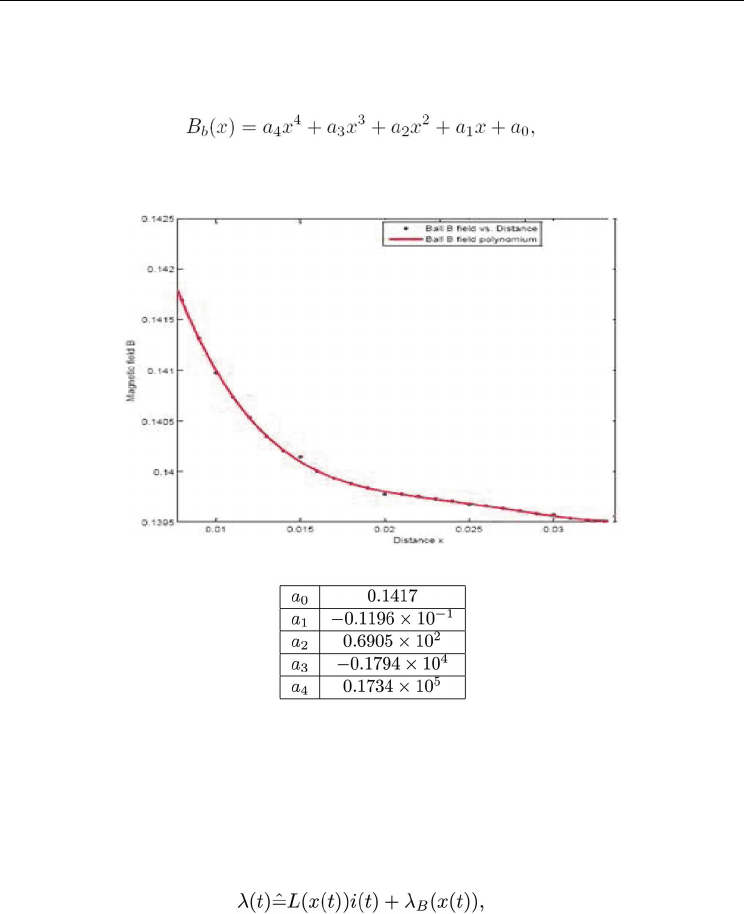
Automation and Robotics
364
be measured by attaching a Hall Effect sensor at the top of the ball and manually moving
the ball up or down within the possible working range. One measurement is shown in
Fig. 6. By using the curve fitting technique, a 4th order polynominal is obtained as
(2)
with coefficients listed in Table. 1. In the following, equation (2) is used as the model of NIB
magnetic field.
Fig. 6. Measured magnetic field generated by NIB via distance
Table.1. Coefficients of B
b
(x) induced by NIB magnet
3.2 Nonlinear system model
Under assumption that the used material has a linear characteristic, i.e., the magnetization
density only depends on the magnetic field density (Woodson & Melcher (1968)), the
magnetic flux of the entire field, denoted as λ (t), can be approximated by
(3)
where i(t) denotes the current through the solenoid, and x (t) denotes the displacement of
the levitated object to the solenoid bottom. L(x) denotes the inductance when the levitated
object is assumed to be iron/steel and it can be regarded as a function of x (t) (Wong (1986);
Yang & Pedersen (2006)). λ
B
(x) is the flux introduced by the NIB magnet, and it also is a
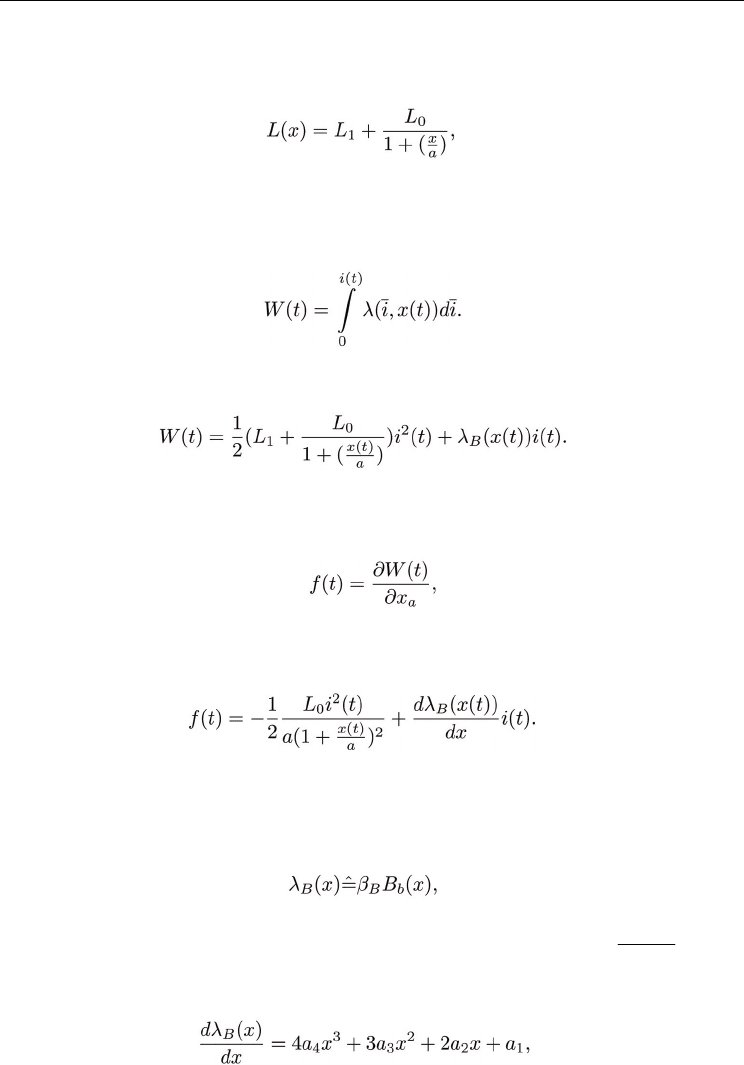
Model-Based Control of a Nonlinear One Dimensional Magnetic Levitation with
a Permanent-Magnet Object
365
function of x(t) as we find out in eq.(2). By using the proposed approximation in (Wong
(1986); Oliveira et al. (1999); Yang & Pedersen (2006)), L(x) can be expressed as
(4)
where L
0
= L(0) - L(∞), L
1
= L(∞) and a is a constant coefficient.
According to the electromagnetic theory (Woodson & Melcher (1968)), the magnetic co-
energy, denoted as W, can be calculated as
(5)
By inserting (3) and (4) into (5), there is
(6)
The introduced magnetic force, denoted as f(t), is determined from the magnetic co-energy
according to
where x
a
represents the force acting axis, which is equal to the x(t) axis. Then from (6) we
have
(7)
Assume that the magnetic flux λ
B
(x) and the magnetic flux density have a constant linear
relationship. It could be reasonable if the considered system only has small moving distance.
There is
(8)
where B
b
(x) is the value calculated from equation (2). Therefore,
()
B
d
d
x
x
λ
can be
approximated by
(9)
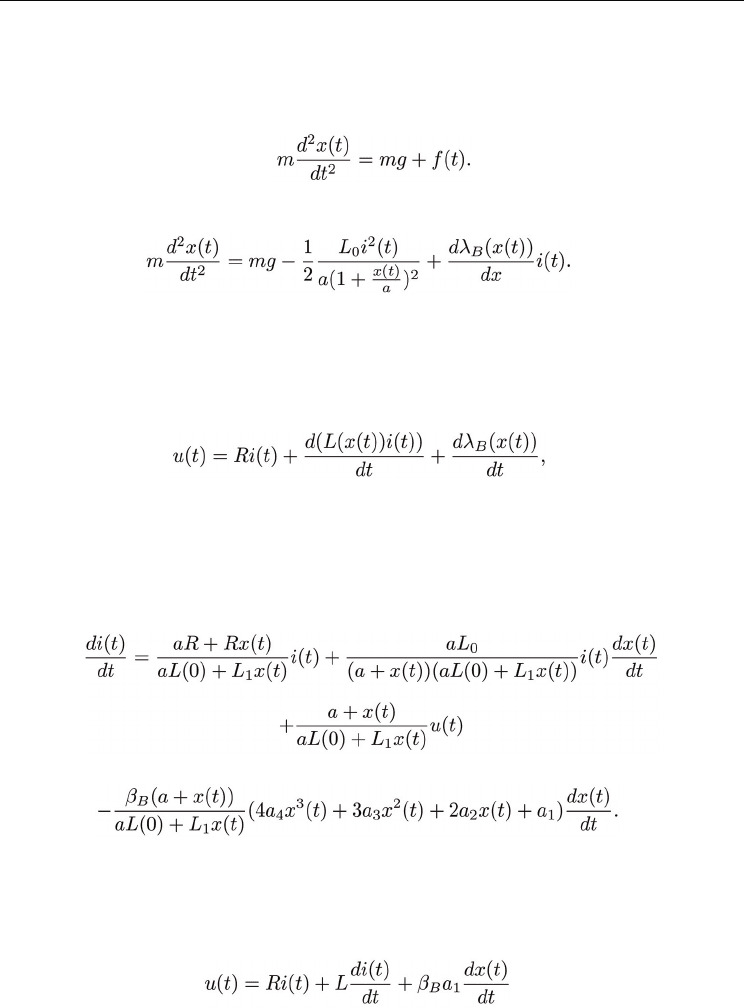
Automation and Robotics
366
with coefficients given in Table 1.
Denote the mass of the levitating object as m and the gravity acceleration as g. By neglecting
the air drag friction, the dynamic of the levitating object can be obtained from Newton's
Second Law as
By inserting (7) into the above equation, there is
(10)
Compared with models used in (Barie & Chiasson (1996); Oliveira et al. (1999); Pedersen &
Yang (2006); Wong (1986); Yang & Pedersen (2006)), the third term on the right side of
equation (10) is new and it is due to the existing of the permanent NIB magnet.
Through circuit analysis, the electrical perspective of the solenoid can be modeled as
(11)
where R is the coil resistance, and u(t) is the input voltage to the coil. Compared with
models used in (Barie & Chiasson (1996); Oliveira et al. (1999); Pedersen & Yang (2006);
Wong (1986); Yang & Pedersen (2006)), the second term on the right side of (11) is new, and
it is the EMF induced by the permanent NIB magnet.
By taking relationship (8) and substituting (4) and (2) into (11), there is
(12)
Without triviality, if a small operating range is considered, the inductance (4) can be
approximated by a constant value (L = 0.1398H). In addition, by taking the linear part of
λ
B
(x), a linear version of equation (12) can be derived as
(13)
which is similar to a simplified linear DC-motor model (Woodson & Melcher (1968)).
Equations (10) and (12) constitute of a nonlinear model of the considered levitation system.
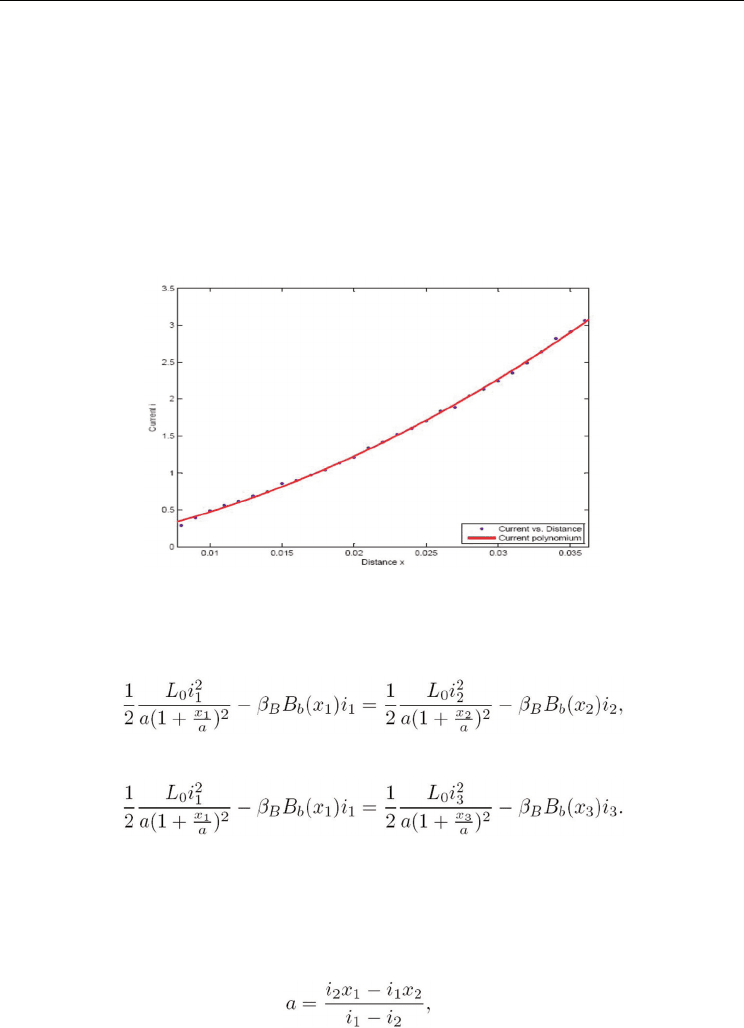
Model-Based Control of a Nonlinear One Dimensional Magnetic Levitation with
a Permanent-Magnet Object
367
Compared with models used in (Barie & Chiasson (1996); Oliveira et al. (1999); Pedersen &
Yang (2006); Wong (1986); Yang & Pedersen (2006)), here the influence of the NIB magnet is
reflected by the extra force in (10) and the EMF part in (12), respectively.
3.3 Coefficient identification
System coefficients L
0
, L(0) and L
1
used in (4) can be directly measured or estimated.
However, coefficients a and β
B
in (10) need to be identified through an experimental
approach similar to those used in (Oliveira et al. (1999); Yang & Pedersen (2006)). A set of
experiments is organized to find the currents required to levitate the object at different
equilibrium positions. The result is plotted in Fig. 7.
Fig. 7. The equilibrium points and corresponding required currents
By picking up three close equilibrium points and their corresponding currents, denoted as
x
1
, x
2
,x
3
and i
1
, i
2
, i
3
, respectively, from (7) there is
and
Coefficient a can be calculated by combining the above two equations. After a is determined,
β
B
can be determined based on any set, e.g., set (x
1
, i
1
). A simple way to determine a is to
assume the term β
B
B
b
(x
k
) i
k
is almost constant for k = 1, 2, 3. This assumption is reasonable
for a small operating range, so a can be determined by
(14)
Correspondingly, β
B
can be determined by
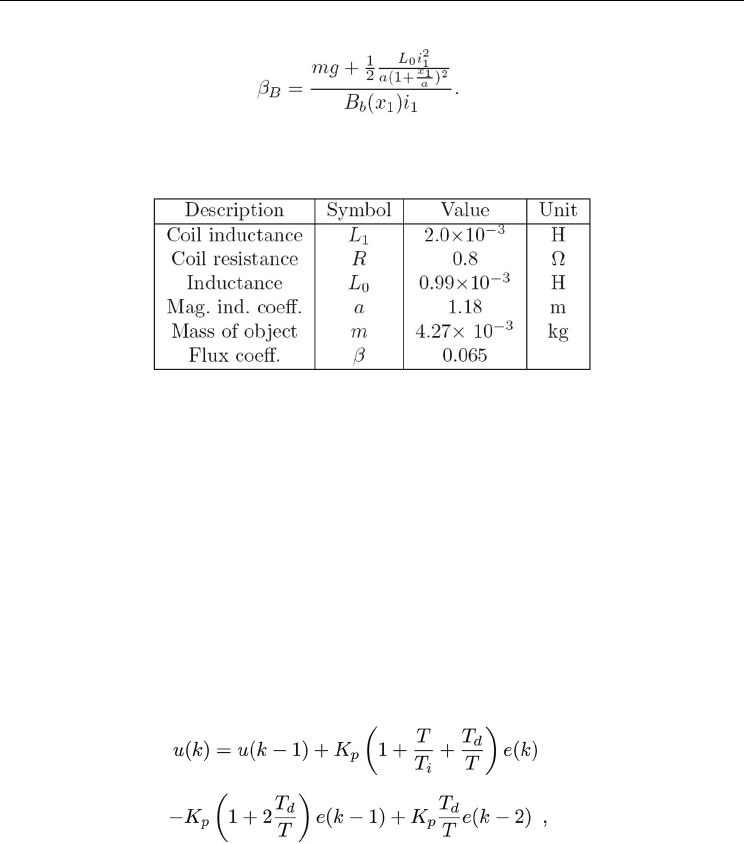
Automation and Robotics
368
(15)
Average values of obtained a and β
B
and other directly measured coefficients are listed in
the Table 2.
Table 2. Parameters used in the considered system
Due to the considered levitation system being naturally unstable and having a very fast
response, it is difficult to validate the developed model directly. Therefore, a simple PID
feedback controller is developed to keep the considered system operating properly. The
mathematical model is validated by comparing the simulated closed-loop control system
and the real controlled system afterwards (Yang et al. (2007)).
4. Design and implementation of PID controllers
4.1 Empirical PID controller
By using the obtained nonlinear model, an analog PID controller is developed and manually
tuned based on the Ziegler-Nichols PID tuning method. Then the developed PID controller
is discretized with a sampling frequency of 480 Hz, which is determined by the NI DAQ
card used for the digital implementation. The implemented controller has the form
(16)
where T, K
p
, T
i
and T
d
are sampling period, P, I, and D coe±cients, respectively. e(k) is the
displacement tracking error. The simulation of the closed-loop control system using the
empirical PID controller is shown in Fig.8. It can be observed that the controlled system has
a reasonable response time and good tracking capacity.
4.2 Automatic tuning of PID controller using GA algorithms
From our preliminary investigation (Pedersen & Yang (2006); Yang & Pedersen (2006)), it
turned out that the PID controller can be automatically tuned using the multi-objective non-
dominated sorting genetic algorithm (NSGA-II) based on the nonlinear system model.
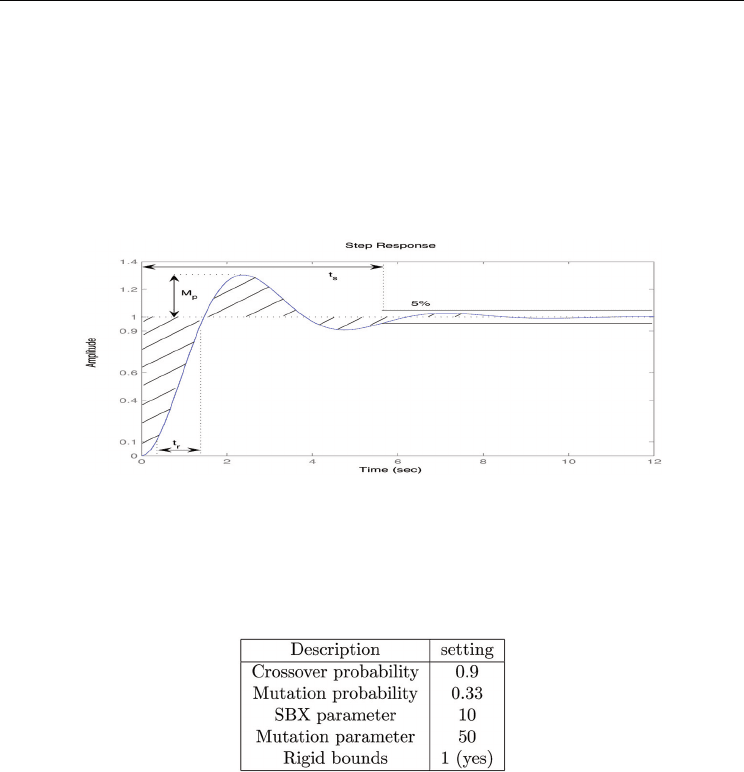
Model-Based Control of a Nonlinear One Dimensional Magnetic Levitation with
a Permanent-Magnet Object
369
The performance induced by different PID-controller parameters are evaluated by the
following criteria based on the step response:
• Overshoot (M
p
);
• Rise time (t
r
);
• Settling time (t
s
); and
• Integrated absolute error (IAE).
An illustration of the performance measures is given in Fig. 9. Each of these performance
measures will be included as objectives to be minimized as their inter-dependence will
depend highly on the nonlinear system expressed by (10) and (12).
Fig. 9. Performance measures for step response
The non-dominated sorting genetic algorithm (NSGA-II) developed in (Deb et al. (2000)) is a
multi-objective algorithm, which can evolve a set of non-dominated solutions that are all
equally well suited for solving the specific problem given the performance measures
specified. Many of the NSGA-II run-time parameters used for here are the same as the
NSGA-II default values (Pedersen & Yang (2006); Yang & Pedersen (2006)), such as
Table. 3. Parameters used for running NSGA-II
In the simulation, The range for K
p
is set to [-1000,0]. The ranges for T
i
and T
d
are both set to
[0,15]. With respect to the computational complexity of the simulations, a population size of
50 individuals was chosen along with a maximum number of generations of 150. Besides
from the use of the 4 objectives a constraint on the allowable amount of overshoot has also
been formulated as only values below 100% was allowed. The distribution of K
p
, T
i
and T
d
for the case where the outliers have been removed is illustrated in Fig. 10.
It is quite obvious that there is a large grouping of individuals for small values of T
i
and K
p
values below -800. A simulation of a typical controller from this cluster, with parameters as
K
p
= -800.46, T
i
= 0.021 and T
d
= 0.06, is shown in Fig. 11.
The corresponding performance measures for this individual are IAE=5 ⋅ 10
-4
, M
p
= 84.82%,
t
r
= 21ms and t
s
= 0.425s. It can be observed that the system response consists of a fast

Automation and Robotics
370
oscillation on top of a slower one. The fast rise time is mainly due to the size of K
p
which is
obviously very aggressive towards positional errors.
Fig. 10. Plot of parameters K
p
, T
i
and T
d
for last generation
Fig. 11. System step response in simulation
4.3 LabView Implementation
The developed controllers are implemented in NI LabView environment on a PC running
Windows XP. Therefore some attention needs to be paid on the real-time issues. For
instance, the connection between the external devices and the LabView environment is
setup manually, even though the DAQ assistant in LabView could more easily create the
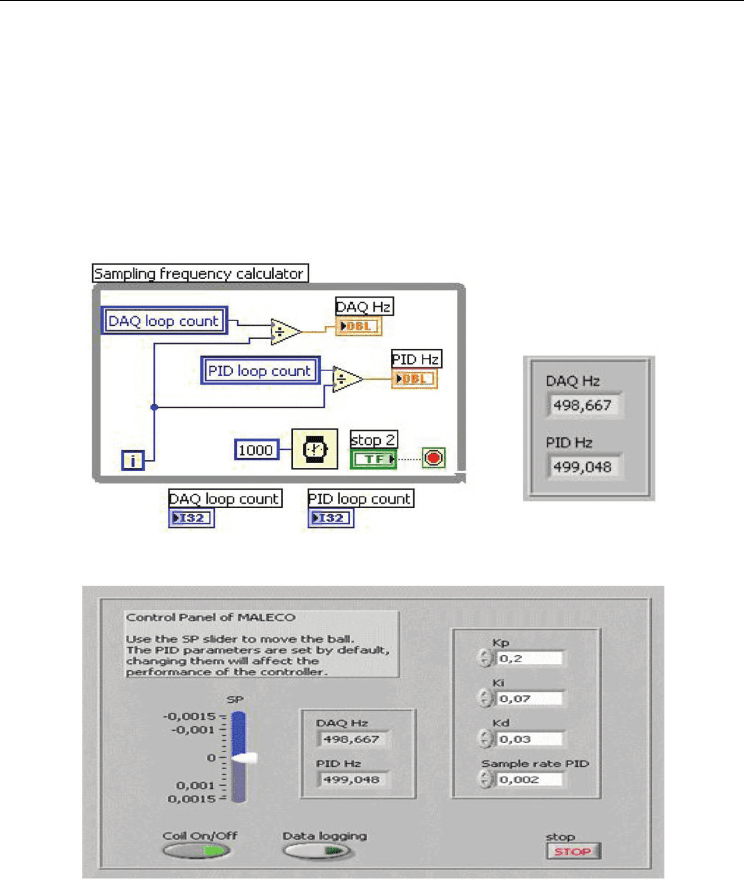
Model-Based Control of a Nonlinear One Dimensional Magnetic Levitation with
a Permanent-Magnet Object
371
communication line. However, our experiences showed that the DAQ Assistant is quite time
consuming, no matter if it is used inside or outside the timed loop (Sønderskov & Østerö
(2007); Yang et al. (2007)). Another real-time issue relevant to the Windows XP operating
system. It is well known that Windows XP gives priority to different processes that are
executed. For example, just moving the mouse is sometimes enough to slow down the
execution of LabView code. In order to solve this real-time problem, the timed loop
structure is used in the LabView program, which guarantees that the LabView code should
be executed within the defined time period. Furthermore, In order to check the sampling
rate issues, a sampling frequency calculator is constructed as shown in Fig. 12. A front panel
of the developed controller is shown in Fig.13.
Fig. 12. Sampling frequency calculator with front panel indicators
Fig. 13. Front panel of the developed controller
5. Testing results and discussions
The simulated performance of the closed-loop control system using the empirical PID
controller is shown in Fig. 8. The same controller is implemented in the LabView program
and tested with the physical setup. One test result based on the same set of set-points as for
simulation is shown in Fig. 14. It can be observed that in principle the controlled physical
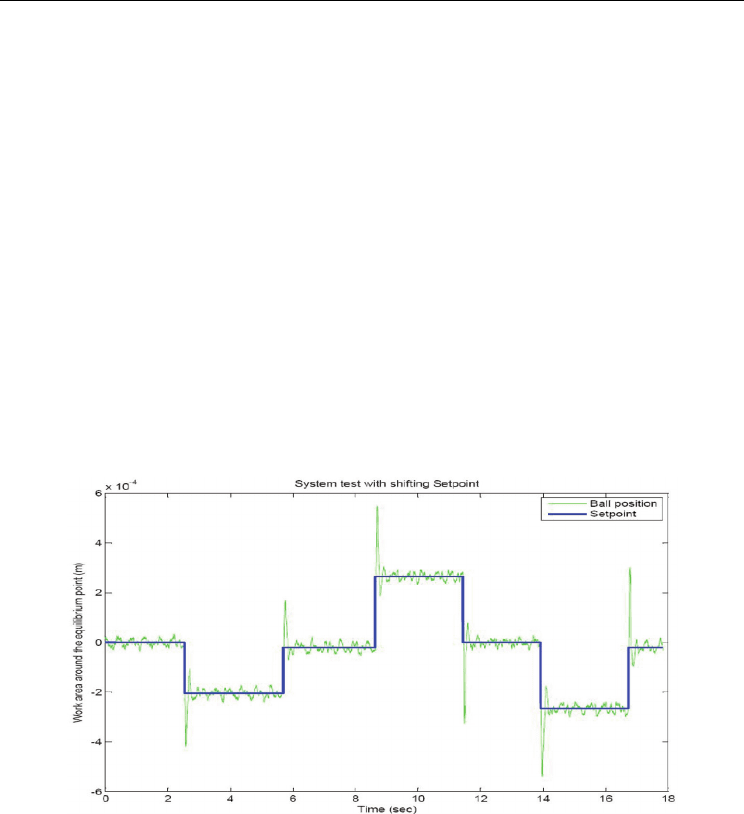
Automation and Robotics
372
system has quite similar performance as the simulation model. However, it is also obvious
that the controlled physical system has much shorter response time and much larger
overshot and oscillation compared with the simulated system performance. The reasons for
these deviations could be explained in the following perspectives:
• Imprecise sensor measurement. The optical position sensor is very sensitive to light
disturbances;
• Frequent switchings of the MOSFET IRFZ44. The frequent on-off switchings of current
due to this MOSFET can directly lead to oscillations in real tests (Yang et al. (2007));
• Imprecise sampling rates of DAQ card and PID computation due to the real-time
problem of Windows XP operating system. This could cause synchronization problems
in data acquisition and control computation;
• the approximation of system coefficients. For example, in a strict sense, the system
coefficient β
B
should be displacement dependent. However, we assume it is always
constant due to simplicity.
The consistency between simulation and real tests could be improved if above problems
could be solved or moderated. By softly changing the set-points, e.g., filtering the
rectangular set- points, the controlled physical system shows a better performance as shown
in Fig. 15. It can be observed that the large overshot that appeared in Fig. 14 has
disappeared.
Fig. 14. Response of the controlled physical setup
One test result using the same control coefficients directly from NSGA-II tuning is shown in
Fig. 16. Compared with the simulation result shown in Fig. 11, this implemented controller
has quite similar behavior as simulation study. However, it is also obvious that the fast
dynamic has much larger amplitude than it does in simulation, which could be due to the
following facts:
• The designed closed-loop system is obviously under-damped;
• The influence from the external disturbances, e.g., the air flow around the ball etc;
• Model uncertainties and unprecise position measurements.
More analysis of these issues will be one part of our future work.
